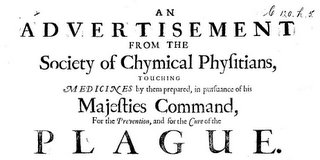


I have been looking at early modern adverts. 'My griefs cry lowder then aduertisement', says Leonato, angry about the 'death' of Hero in Much Ado about Nothing, V i 32. That was how it used to be done: to have your message 'cried in the street', sometimes with a drummer to help the message get heard. Printed ephemera (and I post three headings from single sheet examples), survive as fossils survive, through lucky chances of preservation. There must have been many more species than those that can now be unearthed. These adverts seem to model themselves on royal proclamations, and begin with the ‘Be it known unto all’ formula that the Privy Council would use. If the Crown could proclaim a measure for health, it seems to have occurred to private doctors that they could do the same. Nicholas Bowden, ‘cutter of the stone and also occulest’ (oculist, rather than occultist!) in 1610, lets it be known that he can deal with ruptures, wry necks, cataracts, hare lips, fistulas and difficult childbirths. ‘Those which shall neede of me, shall have me’, concludes his flier.
Salvator Moretto, a later 17th century physician (1647), promises his medical miracles under the pious title, Nothing without God. He leads off on his skills as a dentist and oral hygienist, has a balsam called the ‘spirit of vegetables’ for all kinds of pains, another for wounds, and says he can get rid of the French Pox ‘in a short time, with Gods assistance’. He ‘can also cure many secret diseases which are incident unto women, not fitting to be publiquely named’. Among the other inestimable services offered by this man, he ‘can make hair grow in a short time on a bauld place’.
Rivalry was clearly intense: in one of the first adverts surviving for the famous and long-surviving ‘Daffy’s Elixir’, Antony Daffy vindicates his cure-all against the ‘new upstart counterfeiters of my ELIXIR’ (1675). When a controversy settled down, physicians could unite to advertise themselves: An Advertisement from the Society of Chymical Physicians, announces that now it has been agreed that chemical preservatives are effective against the plague, so here are the premises of eight London physicians where an effective remedy against the plague can be had, ‘at reasonable Rates’. From what I have seen of these ‘preservatives’, you might be expected to wear a taffeta bag of arsenic paste around your neck. If you survived the medicine, this might perhaps have been effective against fleas, still accepted as the vector for the plague. This was in 1665, and does not really seem to have done much good in 1666.
Booksellers, with their ready access to publishers, seem to have been almost as quick to advertise. An early advert for the Oxford University Press survives (1680), and a really remarkable one from Richard Wilkins, a bookseller in
‘Advertisement’ still carries a strong sense of ‘warning’ (the OED's readers missed many earlier examples, and the great dictionary does not have the word used for printed promotional material before 1692) and these documents are often used by people who want to assert their legal rights to an innovation, or property of some kind. William Dockwra, a merchant who had set up a penny post, ‘universally approved, and well known to be a Great and Publicke good’, puts out a flier about his attempt to be re-instated to the business after James II had turned him out of it. Interestingly, the flier has a hand annotation, ‘The Reader is desired not to take away this paper’: another hand annotates the exemplar with the note that ‘This paper was [placed?] in every coffee house in Oxon in the beg. of April 1699’. Presumably this was the kind of circulation that the adverts had, via taverns, or, in the later century, the coffee-houses.
Just occasionally an advert is so bizarre that it seems to confirm the Monty Python view of the past. The Students of the Royal College of Edinburgh announce that they intend to brighten up Christmas day 1689 by burning an effigy of ‘Antichrist the Pope of Rome’ to show their zeal and fervency for the Protestant religion, and warn all ‘Plunderers, Robbers, Thieves, Whores and Bawds’ to keep away from this festive event, ‘under the Pain of Death’. But it is signed ‘Robert Brown, Secretary of State to all our Theatrical and extra-literal Divertisements’, so it looks more like a clever way to raise an early modern flash mob, and may be a prototypical rag week event.
In 1675 an enterprising publisher put out an advert which noted that 'Whereas divers people are at great expense inprinting, publishing, and dispersing Bills of Advertisement', in future, your advert can go into his 'Mercury, or Bills of Advertisement', which will be published every Thursday morning, and be posted through every door in London. And there's your first free 'newspaper'. I'm sure people used to to put in the rabbit's hutch, like I do.
No comments:
Post a Comment